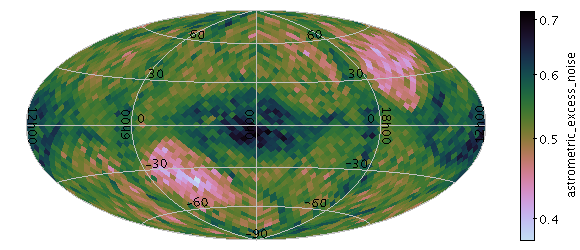
skydensity
Plots a density map on the sky. The grid on which the values are drawn uses the HEALPix tesselation, with a configurable resolution. You can optionally use a weighting for the points, and you can configure how the points are combined to produce the output pixel values.
The way that data values are mapped to colours is usually controlled by options at the level of the plot itself, rather than by per-layer configuration.
Usage Overview:
layerN=skydensity levelN=<-rel-level|+abs-level>
combineN=sum|mean|median|min|max|stdev|count|hit
transparencyN=0..1 lonN=<deg-expr> latN=<deg-expr>
weightN=<num-expr> inN=<table> ifmtN=<in-format>
istreamN=true|false icmdN=<cmds>
All the parameters listed here
affect only the relevant layer,
identified by the suffix
N.
Example:

stilts plot2sky in=tgas_source.fits lon=l lat=b
layer1=skydensity weight1=astrometric_excess_noise combine1=mean level1=4
projection=aitoff auxmap=cubehelix auxfunc=log
xpix=580 ypix=250
combineN = sum|mean|median|min|max|stdev|count|hit ??????(Combiner)
For unweighted values (a pure density map),
it usually makes sense to use
count.
However, if the input is weighted by an additional
data coordinate, one of the other values such as
mean
may be more revealing.
The available options are:
sum: the sum of all the combined valuesmean: the mean of the combined valuesmedian: the median of the combined values (may be slow)min: the minimum of all the combined valuesmax: the maximum of all the combined valuesstdev: the sample standard deviation of the combined valuescount: the number of non-blank values (weight is ignored)hit: 1 if any values present, NaN otherwise (weight is ignored)[Default: sum]
icmdN = <cmds> ??????(ProcessingStep[])
inN.
The value of this parameter is one or more of the filter
commands described in Section 6.1.
If more than one is given, they must be separated by
semicolon characters (";").
This parameter can be repeated multiple times on the same
command line to build up a list of processing steps.
The sequence of commands given in this way
defines the processing pipeline which is performed on the table.
Commands may alteratively be supplied in an external file,
by using the indirection character '@'.
Thus a value of "@filename"
causes the file filename to be read for a list
of filter commands to execute. The commands in the file
may be separated by newline characters and/or semicolons.
ifmtN = <in-format> ??????(String)
inN.
The known formats are listed in Section 5.2.1.
This flag can be used if you know what format your
table is in.
If it has the special value
(auto) (the default),
then an attempt will be
made to detect the format of the table automatically.
This cannot always be done correctly however, in which case
the program will exit with an error explaining which
formats were attempted.
[Default: (auto)]
inN = <table> ??????(StarTable)
-",
meaning standard input.
In this case the input format must be given explicitly
using the ifmtN
parameter.
Note that not all formats can be streamed in this way.<" character at the start,
or a "|" character at the end
("<syscmd" or
"syscmd|").
This executes the given pipeline and reads from its
standard output.
This will probably only work on unix-like systems.istreamN = true|false ??????(Boolean)
inN parameter
will be read as a stream.
It is necessary to give the
ifmtN parameter
in this case.
Depending on the required operations and processing mode,
this may cause the read to fail (sometimes it is necessary
to read the table more than once).
It is not normally necessary to set this flag;
in most cases the data will be streamed automatically
if that is the best thing to do.
However it can sometimes result in less resource usage when
processing large files in certain formats (such as VOTable).
[Default: false]
latN = <deg-expr> ??????(String)
The value is a numeric algebraic expression based on column names as described in Section 10.
levelN = <-rel-level|+abs-level> ??????(Integer)
If the supplied value is a non-negative integer, it gives the absolute level to use; at level 0 there are 12 pixels on the sky, and the count multiplies by 4 for each increment.
If the value is negative, it represents a relative level; it is approximately the (negative) number of screen pixels along one side of a HEALPix sky pixel. In this case the actual HEALPix level will depend on the current zoom.
[Default: -3]
lonN = <deg-expr> ??????(String)
The value is a numeric algebraic expression based on column names as described in Section 10.
transparencyN = 0..1 ??????(Double)
[Default: 0]
weightN = <num-expr> ??????(String)
The value is a numeric algebraic expression based on column names as described in Section 10.